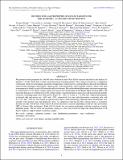REVISED STELLAR PROPERTIES OF KEPLER TARGETS FOR THE QUARTER 1-16 TRANSIT DETECTION RUN
Author(s)
Huber, Daniel; Aguirre, Victor Silva; Matthews, Jaymie M.; Pinsonneault, Marc H.; Gaidos, Eric; Garcia, Rafael A.; Hekker, Saskia; Mathur, Savita; Mosser, Benoit; Torres, Guillermo; Bastien, Fabienne A.; Basu, Sarbani; Bedding, Timothy R.; Chaplin, William J.; Demory, Brice-Olivier; Fleming, Scott W.; Guo, Zhao; Mann, Andrew W.; Rowe, Jason F.; Serenelli, Aldo M.; Smith, Myron A.; Stello, Dennis; ... Show more Show less
DownloadHuber-2014-Revised stellar prop.pdf (2.280Mb)
PUBLISHER_POLICY
Publisher Policy
Article is made available in accordance with the publisher's policy and may be subject to US copyright law. Please refer to the publisher's site for terms of use.
Terms of use
Metadata
Show full item recordAbstract
We present revised properties for 196,468 stars observed by the NASA Kepler mission and used in the analysis of Quarter 1-16 (Q1-Q16) data to detect and characterize transiting planets. The catalog is based on a compilation of literature values for atmospheric properties (temperature, surface gravity, and metallicity) derived from different observational techniques (photometry, spectroscopy, asteroseismology, and exoplanet transits), which were then homogeneously fitted to a grid of Dartmouth stellar isochrones. We use broadband photometry and asteroseismology to characterize 11,532 Kepler targets which were previously unclassified in the Kepler Input Catalog (KIC). We report the detection of oscillations in 2762 of these targets, classifying them as giant stars and increasing the number of known oscillating giant stars observed by Kepler by ~20% to a total of ~15,500 stars. Typical uncertainties in derived radii and masses are ~40% and ~20%, respectively, for stars with photometric constraints only, and 5%-15% and ~10% for stars based on spectroscopy and/or asteroseismology, although these uncertainties vary strongly with spectral type and luminosity class. A comparison with the Q1-Q12 catalog shows a systematic decrease in radii of M dwarfs, while radii for K dwarfs decrease or increase depending on the Q1-Q12 provenance (KIC or Yonsei-Yale isochrones). Radii of F-G dwarfs are on average unchanged, with the exception of newly identified giants. The Q1-Q16 star properties catalog is a first step toward an improved characterization of all Kepler targets to support planet-occurrence studies.
Date issued
2014-02Department
Massachusetts Institute of Technology. Department of Earth, Atmospheric, and Planetary Sciences; Massachusetts Institute of Technology. Department of PhysicsJournal
The Astrophysical Journal. Supplement Series
Publisher
IOP Publishing
Citation
Huber, Daniel, Victor Silva Aguirre, Jaymie M. Matthews, Marc H. Pinsonneault, Eric Gaidos, Rafael A. Garcia, Saskia Hekker, et al. “REVISED STELLAR PROPERTIES OF KEPLER TARGETS FOR THE QUARTER 1-16 TRANSIT DETECTION RUN.” The Astrophysical Journal Supplement Series 211, no. 1 (February 4, 2014): 2. © 2014 The American Astronomical Society
Version: Final published version
ISSN
0067-0049
1538-4365